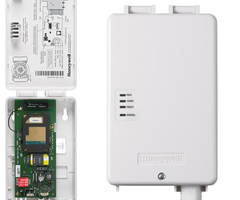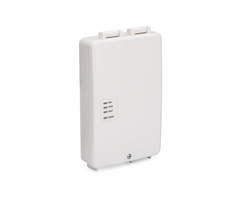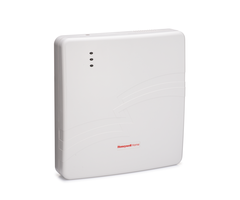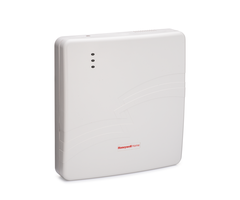How Do I Upgrade a Honeywell VISTA TURBO Series System to Use LTE?
You can upgrade a Honeywell VISTA TURBO System to use LTE by installing and activating an LTE communicator for the system. The Honeywell VISTA TURBO Panels use the same cellular communicators as the VISTA P-Series Panels. You will need a monitoring plan that includes cellular communication.

The Honeywell VISTA TURBO Panel lineup includes the Honeywell VISTA-128BPT and Honeywell VISTA-250BPT Systems. These are commercial-grade hardwired panels that offer more advanced features and capabilities than the VISTA P-Series Panels. The process for upgrading a VISTA TURBO System to LTE is basically the same as the other VISTA Panels. The only real difference is that the numbered terminals for connecting the communicator are slightly different. But other than that, you will follow the same process.
A Honeywell VISTA TURBO Panel is set up with cellular and/or IP connectivity to communicate with the AlarmNet360 Servers. This is necessary for alarm monitoring service. But cellular connectivity is much more reliable than IP connectivity. Cellular service almost never goes down or becomes unavailable, making it perfect for alarm monitoring. That is why many VISTA TURBO users choose to upgrade to cellular. And if you want to get a VISTA TURBO Panel set up for cellular monitoring, you will need an LTE communicator.
Something important happened in June 2019. This was when Resideo stopped allowing activations for 3G and CDMA communicators. This means that only LTE communicators can be activated for cellular alarm monitoring service through AlarmNet360. Eventually, 5G cellular communicators will likely be released, but that has not yet occurred as of early 2020. It may be quite some time before alarm systems begin using 5G communication. For the foreseeable future, LTE isn't just the best option, it is the only option.
Although 3G and CDMA activations are no longer allowed, some VISTA TURBO Panels may be already set up with these communicators. If that is the case, then the user can expect the communicator to continue to work until the associated cellular network is shut down. Cellular service providers like AT&T and Verizon are expected to shut down these older networks sometime in 2022. Once these networks are shut down, then these communicators will become fully obsolete, and they will no longer offer any useful function. Also, if you were to deactivate a 3G or CDMA communicator for any reason, you would not be able to reactivate it.
Some users will certainly try and wait until the last minute to upgrade to LTE. And while that is fine, it is not advised. Upgrading to LTE has many advantages beyond simply keeping the panel monitored. An LTE communicator will offer faster speeds and more reliable connectivity than the older 3G and CDMA modules. You will likely find that the system offers better performance when communicating with AlarmNet360 after you have installed an LTE communicator. This can be important for ensuring a fast response from a central station, and it can help your system respond faster when you control it remotely using Total Connect 2.0.
Being able to control the system remotely from Total Connect 2.0 is a major benefit of upgrading the communication path on a VISTA TURBO Panel. If you aren't familiar with Total Connect 2.0, it is an interactive monitoring and automation platform that you can use to control your system from pretty much anywhere in the world. A VISTA TURBO Series Panel can only support Total Connect 2.0 if it is set up with IP and/or cellular communication through an AlarmNet Communicator.
Please note that while all versions of the VISTA-128BPT can support Total Connect 2.0, a VISTA-250BPT can only support the service if it is running Firmware Version 10.3 or higher. You can determine the system's firmware version by checking its PROM Chip. More information on checking the PROM Chip version and replacing the PROM Chip on a VISTA TURBO Panel can be found in this helpful FAQ. Also note that even if your VISTA-250BPT is on too low of a firmware version to support TC2, you can still use an AlarmNet Communicator to get the system monitored for basic monitoring service.
Some VISTA TURBO users are concerned about upgrading to LTE because they are fearful that LTE networks will eventually be shut down in favor of the upcoming 5G networks. This is something that will most likely not happen until decades in the future. The term LTE stands for "Long-Term Evolution". Cellular service providers like AT&T and Verizon have repeatedly stated that they plan on supporting their LTE networks well into the very distant future. That makes sense considering the tremendous amounts of resources and capital that have been spent installing and maintaining the LTE infrastructure. The cellular service providers have no intention of dropping support for these networks any time soon, even as 5G networks come to fruition. Long story short, upgrading to LTE is a great long-term investment for your panel, and it will allow you to keep your system monitored for many, many years to come.
As for the actual LTE communicators used with the VISTA TURBO Panels, they are the exact same ones used with the VISTA P-Series Panels. The Honeywell LTE-XA (AT&T LTE) and the Honeywell LTE-XV (Verizon LTE) are standalone cellular communicators. The Honeywell LTE-IA (AT&T LTE and IP) and Honeywell LTE-IV (Verizon LTE & IP) are dual-path communicators that offer both cellular and IP service.
Please note that going with a dual-path communicator and using both IP and cellular will most likely not increase your monitoring costs. Most monitoring companies include IP service with any monitoring plan that includes cellular connectivity. Using a dual-path communicator like the LTE-IA or LTE-IV is usually recommended, as there is really no disadvantage to having multiple communication paths available. Please note that if you use a dual-path communicator, then the IP path will be set up through a wired ethernet connection. If you want to get it connected across wireless WIFI, then an ethernet to WIFI bridge like the Alarm.com ADC-W110 is needed. You can learn more about using an ethernet to WIFI bridge in this FAQ.
As for the decision of whether to go with AT&T or Verizon, you should base your decision on which network provides better service in your area. Check coverage maps, and go with the one that you feel will work best. If you don't feel like either network will provide adequate service in your area, then you can most likely boost the cell signals for your system using a cellular antenna or a cellular amplifier. Remember, choosing one service provider over the other will not result in any savings in your monitoring expenses. Also, this decision has absolutely nothing to do with the service provider you use for your phone. Just go with whichever one providers the more reliable coverage in the area where the system will be used.
The last thing you must keep in mind is that you will need to get a cellular monitoring plan to support the communicator. Examples compatible monitoring plans include the Alarm Grid Gold and Platinum Plans (Self or Full) and the Alarm Grid Cellular-Only Plan. You should shop around for different monitoring plans and choose the one that best meets your needs. If you decide to go with Alarm Grid monitoring, understand that all our plans are no-contract, and there are never any hidden or surprise fees.
For this FAQ, we will assume that you have a VISTA-128BPT or a VISTA-250BPT System and that no PROM Chip upgrade is needed. Complete the following steps to upgrade a VISTA TURBO System to LTE:
1. Power down the panel. You must power down the panel before making any hardware change. Disconnect the backup battery, and unplug the transformer to power down the system. Make sure the system is completely powered down before continuing.
2. Install the communicator. You should now install the communicator. Please refer to the instruction manual for the communicator for more information on this process. We also have a brief overview of the connections for the LTE-IA and LTE-IV listed below:
- Terminal 3 on the Communicator to Terminal 6 on the Panel for Positive Power (Red wire)
- Terminal 4 on the Communicator to Terminal 7 on the Panel for GND (Black wire)
- Terminal 5 on the Communicator to Terminal 9 on the Panel for data from panel (Yellow wire)
- Terminal 6 on the Communicator to Terminal 8 on the Panel for data to panel (Green wire)
If you are using an LTE-IA or LTE-IV, then you must connect Terminals 1 and 2 on the Communicator to the 1361 Transformer terminals. A 1361 Transformer comes included with these communicators for this exact purpose. The panel and the communicator must use separate transformers for power. The LTE-IA or LTE-IV will also use its own backup battery for backup power.
The LTE-XA and LTE-XV both use a 4-wire connection with the panel. Two (2) wires are for power, and two (2) wires are for communication. These communicators both draw all their power from the panel. The Positive (+) Power Terminal on the communicator (Red wire) should go to Panel Terminal 6. The Negative (-) Power Terminal on the communicator (Black wire) should go to Panel Terminal 7. The Data In Terminal on the communicator (Yellow wire) should go to Panel Terminal 9. The Data Out Terminal on the communicator (Green wire) should go to Panel Terminal 8.
Additionally, make sure to write down the MAC and CRC codes for the communicator before installing. You will need the these codes when you go to activate the communicator. These codes can be found on a white sticker on the communicator. It may also be found on the product packaging for the module.
3. Activate the communicator. Contact your alarm monitoring company, and have them activate the communicator. If you are setting up service with Alarm Grid, then you will work with an Alarm Grid activator. You will choose an activation slot when signing-up for monitoring service, and an activator will contact you at the scheduled time. If you are an existing Alarm Grid customer, and you are looking to upgrade your VISTA TURBO Panel to LTE, then contact us at support@alarmgrid.com. We will work with you to set up a good time to activate the communicator. Remember that our support hours run from 9am to 8pm ET M-F.
Once your activation is complete, make sure to have your monitoring company test your cellular signals. Weak cell signals can prevent your system from communicating successfully with AlarmNet360. Your monitoring company will be able to conduct a thorough test to see if your system's cellular signals are adequate. If your cell signals are too weak, you may need to add a cellular amplifier or a cellular antenna.
Did you find this answer useful?
We offer alarm monitoring as low as $10 / month
Click Here to Learn MoreRelated Products




Related Categories
- Answered


